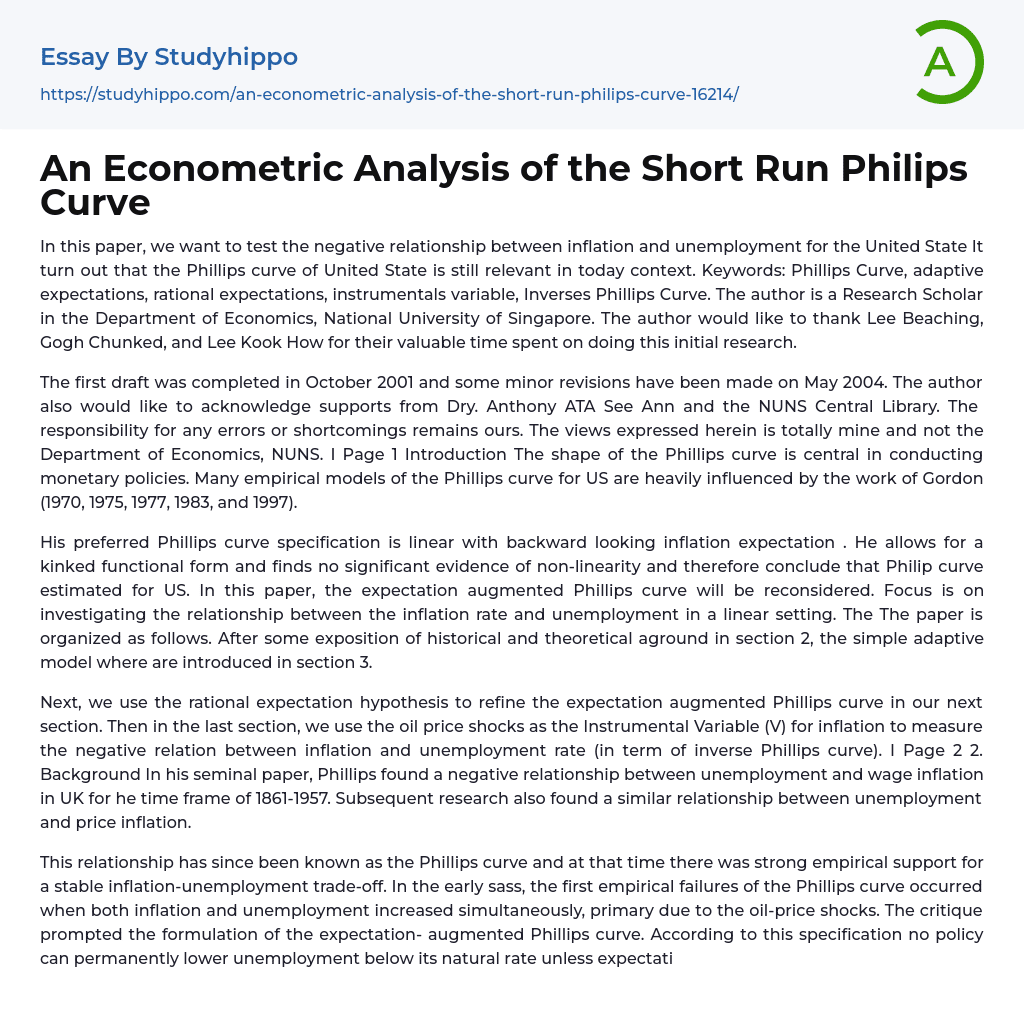

An Econometric Analysis of the Short Run Philips Curve Essay Example
The aim of this paper is to examine the inverse relationship between inflation and unemployment in the United States. The relevance of the Phillips curve in today's context is emphasized. Keywords such as Phillips Curve, adaptive expectations, rational expectations, instrumental variables, and Inverse Phillips Curve are mentioned. The author of this research holds a position as a Research Scholar in the Department of Economics at the National University of Singapore. Gratitude is expressed towards Lee Beaching, Gogh Chunked, and Lee Kook How for their valuable contributions to the initial research. The first draft of this paper was completed in October 2001 with minor revisions made in May 2004. Support from Dr.Anthony ATA See Ann and the NUNS Central Library is acknowledged. Any errors or shortcomings are solely attributed to the author alone. The views presented in this paper are personal opinions an
...d do not represent those of the Department of Economics, NUNS.
On page 1 Introduction: it is highlighted that understanding the shape of the Phillips curve plays a vital role in making monetary policy decisions. Many empirical models used to analyze the Phillips curve for US heavily rely on Gordon's (1970, 1975, 1977, 1983, and 1997) work which favors a linear specification with backward-looking inflation expectations.The text explores analyzing the Phillips curve and examines the linear connection between inflation and unemployment.Thus,the paper aims to test negative relationship between inflation &unemploymentThe author of the paper acknowledges the possibility of a kinked functional form but does not find significant evidence of non-linearity. As a result, they conclude that the estimated Phillips curve for the United States remains valid. The paper is structured into different sections, with section
2 providing background information and theory, section 3 introducing the simple adaptive model, and the following section refining the expectation augmented Phillips curve using rational expectations. Finally, in the last section, oil price shocks are used as instrumental variables to measure the inverse Phillips curve – a negative correlation between inflation and unemployment rate. This concept was first observed by Phillips in his study on UK data from 1861-1957 which revealed a negative relationship between unemployment and wage inflation. Subsequent research also identified a similar link between unemployment and price inflation. Initially referred to as the Phillips curve, this theory had strong empirical support showing a stable trade-off between inflation and unemployment. However, in the early 1970s, there were empirical failures when both inflation and unemployment increased simultaneously due to oil price shocks. These critiques led to the development of the expectation-augmented Phillips curve which states that reducing unemployment below its natural rate permanently is only possible if people's expectations are highly irrational.The "new Phillips curve" has sparked renewed interest as there is significant theoretical work suggesting a non-linear relationship between inflation and unemployment. However, various theories propose different non-linear relationships, making the exact shape of this nonlinearity uncertain. The data used in this study are quarterly data that have been seasonally adjusted and span from the year Errol 4 Nine Notation measure uses. These data measure the annual changes in inflation expectations, which are calculated as a measure of expected inflation over the next year at a certain time period.
- Research Methods essays
- Experiment essays
- Hypothesis essays
- Observation essays
- Qualitative Research essays
- Theory essays
- Explorer essays
- Culture essays
- Social Control essays
- Citizenship essays
- Social Justice essays
- Caste System essays
- Social Responsibility essays
- Socialization essays
- Deviance essays
- Modern Society essays
- Popularity essays
- Civil Society essays
- Community essays
- Female essays
- Filipino People essays
- Igbo People essays
- Indigenous Australians essays
- Indigenous Peoples essays
- Minority Group essays
- Social Institution essays
- Men essays
- The nation essays
- Middle Class essays
- Social Norms essays
- Discourse Community essays
- Popular Culture essays
- Car Culture essays
- American Culture essays
- Mormon essays
- Indian Culture essays
- Mexican Culture essays
- Pop Culture essays
- Cultural Differences essays
- Culture Shock essays
- Different Cultures essays
- Electronics essays
- Computer Science essays
- Consumer Electronics essays
- Enterprise Technology essays
- Hardware essays
- Robot essays
- engineering essays
- people search essays
- Modern Technology essays



